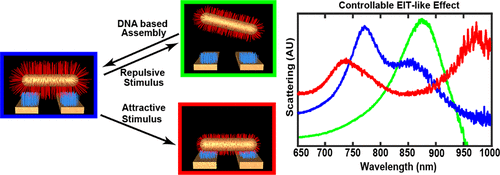当前位置:
X-MOL 学术
›
Nano Lett.
›
论文详情
Our official English website, www.x-mol.net, welcomes your feedback! (Note: you will need to create a separate account there.)
Hybrid Lithographic and DNA-Directed Assembly of a Configurable Plasmonic Metamaterial That Exhibits Electromagnetically Induced Transparency
Nano Letters ( IF 10.8 ) Pub Date : 2018-01-11 00:00:00 , DOI: 10.1021/acs.nanolett.7b04116 David B. Litt 1, 2 , Matthew R. Jones 1 , Mario Hentschel 2 , Ying Wang 2, 3 , Sui Yang 2, 3 , Hyun Dong Ha 1, 2 , Xiang Zhang 2, 3 , A. Paul Alivisatos 1, 2, 4, 5
Nano Letters ( IF 10.8 ) Pub Date : 2018-01-11 00:00:00 , DOI: 10.1021/acs.nanolett.7b04116 David B. Litt 1, 2 , Matthew R. Jones 1 , Mario Hentschel 2 , Ying Wang 2, 3 , Sui Yang 2, 3 , Hyun Dong Ha 1, 2 , Xiang Zhang 2, 3 , A. Paul Alivisatos 1, 2, 4, 5
Affiliation

|
Metamaterials are architectures that interact with light in novel ways by virtue of symmetry manipulation, and have opened a window into studying unprecedented light-matter interactions. However, they are commonly fabricated via lithographic methods, are usually static structures, and are limited in how they can react to external stimuli. Here we show that by combining lithographic techniques with DNA-based self-assembly methods, we can construct responsive plasmonic metamaterials that exhibit the plasmonic analog of an effect known as electromagnetically induced transparency (EIT), which can dramatically change their spectra upon motion of their constituent parts. Correlative scanning electron microscopy measurements, scattering dark-field microscopy, and computational simulations are performed on single assemblies to determine the relationship between their structures and spectral responses to a variety of external stimuli. The strength of the EIT-like effect in these assemblies can be tuned by precisely controlling the positioning of the plasmonic nanoparticles in these structures. For example, changing the ionic environment or dehydrating the sample will change the conformation of the DNA linkers and therefore the distance between the nanoparticles. Dark-field spectra of individual assemblies show peak shifts of up to many tens of nanometers upon DNA perturbations. This dynamic metamaterial represents a stepping stone toward state-of-the-art plasmonic sensing platforms and next-generation dynamic metamaterials.
中文翻译:

可配置的等离激元超材料的混合光刻和DNA定向组装,具有电磁感应的透明性
超材料是通过对称操纵以新颖的方式与光进行交互的体系结构,并为研究前所未有的光-质相互作用打开了一个窗口。但是,它们通常是通过光刻方法制造的,通常是静态结构,并且它们对外部刺激的反应方式受到限制。在这里,我们表明,通过将光刻技术与基于DNA的自组装方法相结合,我们可以构建具有反应性的等离子体超材料,该材料具有等离子体效应,即所谓的电磁感应透明性(EIT),可以在其运动时极大地改变其光谱组成部分。相关扫描电子显微镜测量,散射暗场显微镜,在单个组件上执行计算仿真,以确定它们的结构与对各种外部刺激的光谱响应之间的关系。通过精确控制等离激元纳米粒子在这些结构中的位置,可以调整这些组件中类似EIT效应的强度。例如,改变离子环境或使样品脱水将改变DNA接头的构象,并因此改变纳米颗粒之间的距离。单个组件的暗场光谱显示,在DNA扰动下,峰位移最高可达数十纳米。这种动态超材料是通往最先进的等离子传感平台和下一代动态超材料的垫脚石。通过精确控制等离激元纳米粒子在这些结构中的位置,可以调整这些组件中类似EIT效应的强度。例如,改变离子环境或使样品脱水将改变DNA接头的构象,并因此改变纳米颗粒之间的距离。单个组件的暗场光谱显示,在DNA扰动下,峰位移最高可达数十纳米。这种动态超材料是通往最先进的等离子传感平台和下一代动态超材料的垫脚石。通过精确控制等离激元纳米粒子在这些结构中的位置,可以调整这些组件中类似EIT效应的强度。例如,改变离子环境或使样品脱水将改变DNA接头的构象,并因此改变纳米颗粒之间的距离。单个组件的暗场光谱显示,在DNA扰动下,峰位移最高可达数十纳米。这种动态超材料是通往最先进的等离子传感平台和下一代动态超材料的垫脚石。改变离子环境或使样品脱水将改变DNA接头的构象,从而改变纳米颗粒之间的距离。单个组件的暗场光谱显示,在DNA扰动下,峰位移最高可达数十纳米。这种动态超材料是通往最先进的等离子传感平台和下一代动态超材料的垫脚石。改变离子环境或使样品脱水将改变DNA接头的构象,从而改变纳米颗粒之间的距离。单个组件的暗场光谱显示,在DNA扰动下,峰位移最高可达数十纳米。这种动态超材料是通往最先进的等离子传感平台和下一代动态超材料的垫脚石。
更新日期:2018-01-11
中文翻译:

可配置的等离激元超材料的混合光刻和DNA定向组装,具有电磁感应的透明性
超材料是通过对称操纵以新颖的方式与光进行交互的体系结构,并为研究前所未有的光-质相互作用打开了一个窗口。但是,它们通常是通过光刻方法制造的,通常是静态结构,并且它们对外部刺激的反应方式受到限制。在这里,我们表明,通过将光刻技术与基于DNA的自组装方法相结合,我们可以构建具有反应性的等离子体超材料,该材料具有等离子体效应,即所谓的电磁感应透明性(EIT),可以在其运动时极大地改变其光谱组成部分。相关扫描电子显微镜测量,散射暗场显微镜,在单个组件上执行计算仿真,以确定它们的结构与对各种外部刺激的光谱响应之间的关系。通过精确控制等离激元纳米粒子在这些结构中的位置,可以调整这些组件中类似EIT效应的强度。例如,改变离子环境或使样品脱水将改变DNA接头的构象,并因此改变纳米颗粒之间的距离。单个组件的暗场光谱显示,在DNA扰动下,峰位移最高可达数十纳米。这种动态超材料是通往最先进的等离子传感平台和下一代动态超材料的垫脚石。通过精确控制等离激元纳米粒子在这些结构中的位置,可以调整这些组件中类似EIT效应的强度。例如,改变离子环境或使样品脱水将改变DNA接头的构象,并因此改变纳米颗粒之间的距离。单个组件的暗场光谱显示,在DNA扰动下,峰位移最高可达数十纳米。这种动态超材料是通往最先进的等离子传感平台和下一代动态超材料的垫脚石。通过精确控制等离激元纳米粒子在这些结构中的位置,可以调整这些组件中类似EIT效应的强度。例如,改变离子环境或使样品脱水将改变DNA接头的构象,并因此改变纳米颗粒之间的距离。单个组件的暗场光谱显示,在DNA扰动下,峰位移最高可达数十纳米。这种动态超材料是通往最先进的等离子传感平台和下一代动态超材料的垫脚石。改变离子环境或使样品脱水将改变DNA接头的构象,从而改变纳米颗粒之间的距离。单个组件的暗场光谱显示,在DNA扰动下,峰位移最高可达数十纳米。这种动态超材料是通往最先进的等离子传感平台和下一代动态超材料的垫脚石。改变离子环境或使样品脱水将改变DNA接头的构象,从而改变纳米颗粒之间的距离。单个组件的暗场光谱显示,在DNA扰动下,峰位移最高可达数十纳米。这种动态超材料是通往最先进的等离子传感平台和下一代动态超材料的垫脚石。



























 京公网安备 11010802027423号
京公网安备 11010802027423号